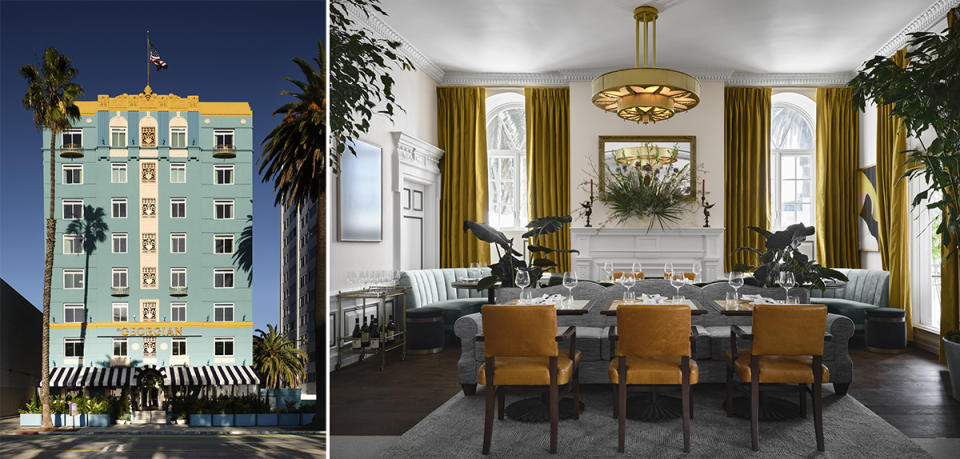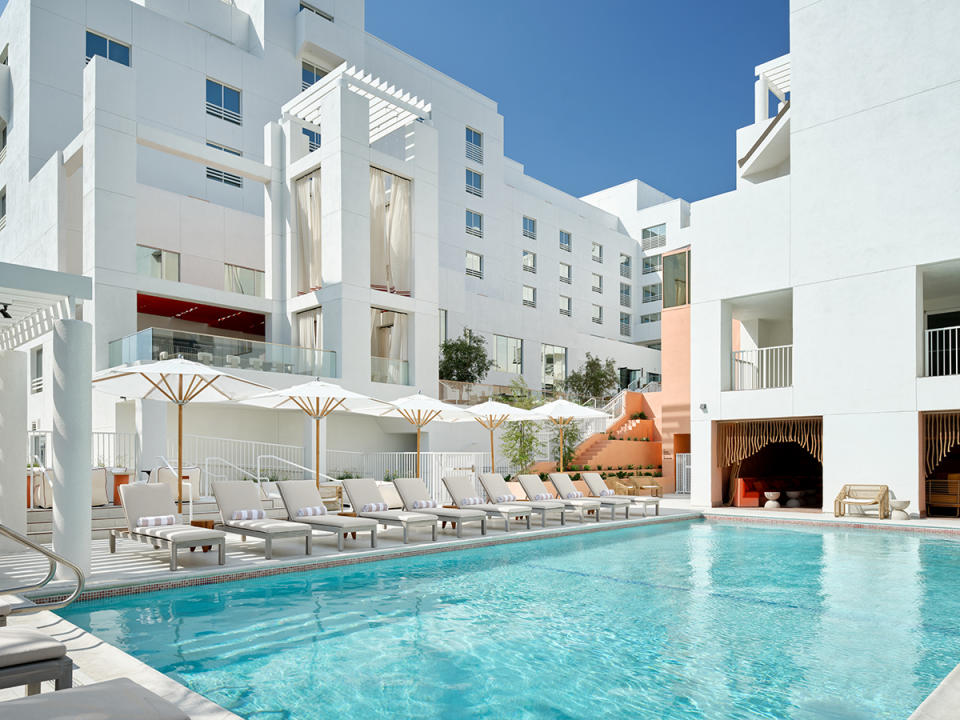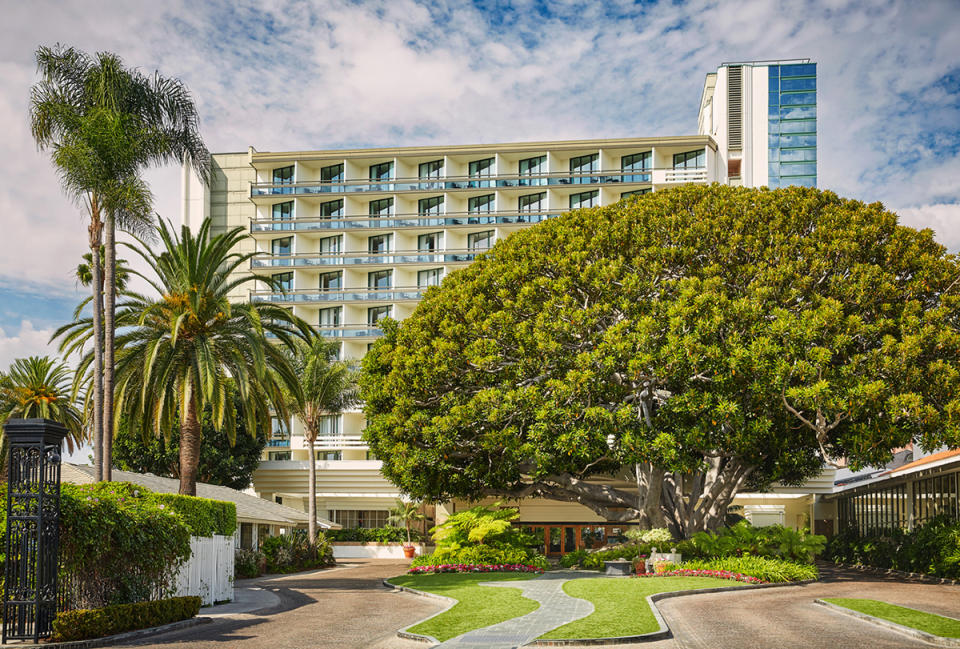Santa Monica Is Getting Gussied Up With New Luxury Hotels. Here’s Everything We Know.

There’s little hyperbole in calling Santa Monica’s Ocean Avenue one of the most iconic stretches of property on the planet. Anchored by the world-famous pier, it runs from one of the most celebrated stretches of sand up to the bluffs that define the palm-studded greenery of Palisades Park. This is where Pamela Anderson and David Hasselhoff ran in slow motion in Bay Watch, all coconut oil and bouncing hair. It’s only a block from where the Z-Boys invented modern day skateboarding. This is where Jack Tripper greased his elbow at the Regal Beagle in Three’s Company.
In recent years, Ocean Ave. hasn’t lived up to the nostalgia. Homelessness, hands-off policing, Prop 47, (which reduced most drug possession and theft sentencing) and a myriad of socio-economic problems have contributed to the decline of the area’s popularity, especially with Angelenos. The traffic, parking, and clueless tourist hordes only added to the slump.
More from Robb Report
A Prominent Restaurant Family's Longtime Beverly Hills Home Hits the Market for $5.6 Million
An Architecturally Significant Modernist 'Treehouse' Is up for Grabs in L.A. at $2.4 Million
“They’re all factors,” concedes Kathleen Rohan, former CEO of Downtown Santa Monica Inc. Between 1997 and 2022, Rohan was in charge of advocacy, economic development, urban safety, beautification, and event promotion for the Bay City. “We’re also surrounded by L.A. County, not freaking Mayberry. With that comes big city benefits, and big city concerns.”
Rohan argues that the real crisis in Santa Monica isn’t drugs or homelessness, it’s something more insidious: a fog of monotony and bland development that threatens the area’s attractiveness and creative spirit. Plenty of others agree. In 2021, the Santa Monica Daily Press wrote: “With ample vacancies and enough chain stores to replicate any mall in America, it’s no secret that the Promenade no longer holds the luster of its past.”

“We do have an opportunity to reset,” Rohan says. “Because it did get to a tipping point that made Santa Monica very generic, and the community doesn’t want generic.”
Now, thankfully, that reset is well underway.
“Back in 2020, we’d call investors and say, ‘We’re raising money to buy this hotel in Santa Monica.’ And they’re like, ‘Santa Monica? No one goes to Santa Monica,’” says Nicolo Rusconi, the L.A.-based hotelier and real estate investor. “We’d say, ‘Because it’s one of the best hospitality tourism markets in the country and because no one goes to Santa Monica!’”
Last year, Rusconi re-opened the 84-room Georgian Hotel on Ocean Ave. Dating back to 1933, in its heyday, the Art Deco showstopper was the crown jewel of Santa Monica. Dubbed the First Lady, it hosted Hollywood royalty like Charlie Chaplin and American royalty like Rose Kennedy—as well as toughs like Mickey Cohen, Bugsy Siegel, and Al Capone. Legend has it that Clark Gable used the Georgian as his hideaway for affairs with then-mistress Carole Lombard.
But like Santa Monica itself, over the decades, the M. Eugene Durfe–designed hotel fell off, along with much of the northern stretch of Ocean Avenue. The renovation preserves the turquoise facade, the dramatic arches, crown moldings and intricate ceiling reliefs while removing corny 1980s bathrooms elements The redesign imagines an Angeleno version of a Wes Anderson movie, dressing the bellboys in Grand Budapest Hotel-inspired uniforms and drenching the hotel in Accidentally Wes Anderson-like pastel colorways. The team commissioned vintage-looking but also slightly exaggerated custom furniture throughout and installed Victrola phonographs in every room.

“For us the Georgian wasn’t the sole opportunity,” says Rusconi, whose BLVD Hospitality team handled the project with the design firm Fettle. “The opportunity was taking back Ocean Avenue and the Westside for the people that are born and raised here, who have fallen in love with this idea of the California dream. But maybe they haven’t been able to deeply appreciate or experience everything that Santa Monica had to offer because it just lost its local luster a little bit.”
Rusconi isn’t alone. A new entertainment zone clears red tape for rooftop bars and restaurants, adding basement speakeasies, alleyway activations, and a car-free “town square.” It would also create a bar-friendly area where pedestrians could walk from one establishment to the other with drink in hand, without friction . . . or open container citations.
Meanwhile, another Ocean Avenue staple, the Viceroy, recently underwent a $21 million facelift to its lobby and Sugar Palm restaurant, with a more comprehensive renovation of its guest rooms currently underway. The more affordable Pierside, not quite as swanky as its Ocean Ave brethren reopened just last year after a $38 million rebuild.

In May, the Sandbourne Santa Monica hotel opened, reinventing Ocean Ave.’s erstwhile Le Merigot, adding a more localized California flare. The new hotel razes walls throughout common areas to expose the hotel’s pool to the ocean and opens its new chef Raphael Lunetta–helmed restaurant to the salty breeze. The remodel spearheaded by Icelandic designer Gulla Jónsdóttir also looks to accentuate the 175-room hotel’s greatest asset: its massive terraces. Under the Le Merigot banner these studio-sized balconies were underutilized, while the Sandbourne makes them a prime selling point—a place to enjoy an afternoon negroni while gazing at the Pier’s famed ferris wheel.
Meanwhile, the hotel responsible for launching Santa Monica’s first hotel boom in the late 1990s, the Loews, is finishing up a mammoth reinvention eclipsing $150 million. This summer, the Loews Santa Monica Beach Hotel will become the 5-star Regent Santa Monica Beach—the rebranded Regent Hotels & Resorts’s first destination in the Americas.
“It is a full renovation and repositioning of a building that’s been an anchor for the city for over 30 years,” says Younes Atallah, Regent’s general manager. Atallah adds that since 1990, it has been impossible to construct any new hotels west of Ocean Ave. thanks to Proposition S, forcing hotel developers to purchase existing buildings at tremendous cost.

The new iteration shrunk the previous hotel’s 347 rooms to just 200, creating entry-level offerings that stretch over 700 square feet—helping it to compete with luxury brands like Montage, Peninsula, and Rosewood.
“Santa Monica is very iconic with postcard-worthy views, so this was an opportunity to align it with other ultra-luxury resorts,” says Atallah.
Still, that’s not all that’s coming to Ocean Ave. The Fairmont Miramar Hotel in Santa Monica has been proposing ambitious plans since 2013, however the city’s strict development laws have forced numerous reorganizations. A plan finally passed in March 2022, which will completely reimagine the century-old hotel and its 4.5 acres. Owners MSD Capital’s plans include a swooping 10-story, 312-room hotel with 60 residential condominiums attached, a more than 400-car parking garage, and 14,000 square feet of public gardens—all set around the historic hotel’s beloved 150-year-old Moreton Bay Fig Tree. The property’s infamous Bungalow bar will live on, as will its FIG restaurant, with more than 18,000 square-feet of retail space added on.
But the plan most sure to excite the old school Santa Monica creatives is the ambiguously named Ocean Avenue Project. It consists of a 35,500-square-foot “Cultural Uses Campus” located across from Palisades Park on the corner of Ocean Ave. and Santa Monica Boulevard designed entirely by Santa Monica native Frank Gehry. It will also feature a museum honoring arguably America’s greatest living starchitect (guess who?).

The design combines the rippling stainless steel found in Gehry’s Guggenheim Museum Bilbao and L.A.’s Walt Disney Concert Hall with the post-modern material conflation that defined his earlier works. The so-called Cultural Uses Campus will feature a 120-room hotel, apartments, and a public 5,000-square-foot rooftop deck.
With Gehry, developers seem to be banking on bringing the Bilbao Effect—a building so iconic, so visually mesmerizing, that it literally empowers an entire city—to Santa Monica.
“That’s the impact that buildings have, and nothing has a bigger impact than a hotel on the culture of a community,” Rusconi says. “Once you start recognizing that you realize your responsibility extends outside of the envelope of a building, and on some level it starts extending to politics, business development, and city initiatives on travel and tourism.”
At the top of the marble staircase leading down to his Georgian Bar, with the Sunset Terrace restaurant just outside the front doors, Rusconi stops to gaze out the window.
“You drive down the California incline and you see the palm trees lining Ocean Avenue, watching the sun set over the bluffs, and you fall in love,” he says. “I fall in love with it every single time.”
Best of Robb Report
The Ultimate Miami Spa Guide: 15 Luxurious Places to Treat Yourself
The 7 Most Insanely Luxurious Spas in the World, From Tokyo to Iceland
17 Reasons the Caribbean Should Be at the Top of Your Travel Itinerary
Sign up for Robb Report's Newsletter. For the latest news, follow us on Facebook, Twitter, and Instagram.


